Last Updated on September 17, 2024
Ever harvested lavender and noticed that not only those lovely flower buds, but the delicate grey leaves also smelled utterly divine? If you’ve ever wondered whether you can use lavender’s pretty, fragrant leaves, read on to find out what to do with lavender leaves. It turns out there are many excellent uses for lavender leaves!
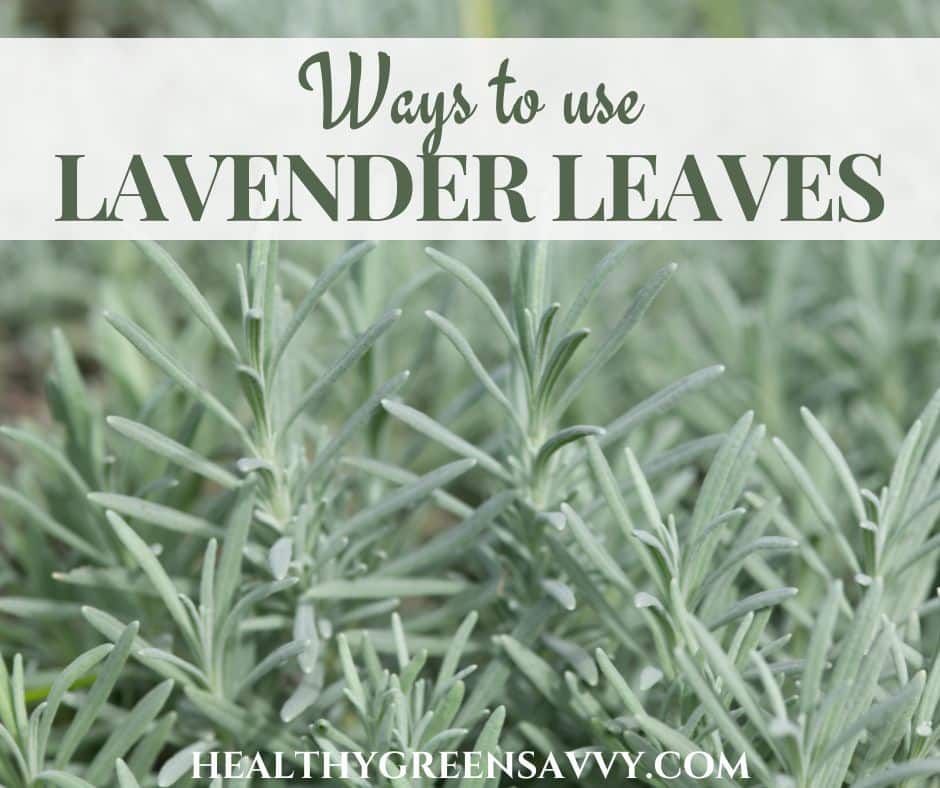
WAIT, YOU CAN USE LAVENDER LEAVES?
Yes, not only those pretty little buds can be used for tea, cooking, and body care products, but the delightfully fragrant leaves of the lavender plant have some lovely uses as well.
I’m all about making the most of what we can grow and forage around here, and learning to use more of our favorite plants for teas, medicines, and cooking is one way I love to get more out of my garden.
Whether it’s unusual uses for orange peels, banana peel tea, or foraging from conifer trees for delicious spruce tea or pine needle tea, I try to waste no opportunity to get something from what seems like nothing.
Here are more than 40+ root to stem recipes to explore. You may be stunned to find out how much great food you’ve been tossing all these years. Looking at you, squash seeds and edible broccoli leaves!
We’ve even figured out some creative ways to use edible sunflower petals and poisonous rhubarb leaves!
So let’s train our waste-less sights on the lovely leaves of the lavender plant and see what excellent uses we can put them to.
WHAT ARE LAVENDER LEAVES?

You’re likely more familiar with the little purple buds of the lavender plant, which are what is generally used to make all the lavender-scented body products, room sprays, and of course, essential oil.
That part of the plant is the flower. Like other plants, lavender uses its leaves for photosynthesis. While your lavender plant might produce a number of little buds, it will be covered in many times more leaves. Learning how to use them expands how much you can do with your lavender crop.
Go give some of those leaves a sniff. You might be surprised how strongly they smell like lavender as well. The potent smell of lavender leaves points to the fact that they also contain compounds like those in lavender buds.
The essential oil distilled from those flowers has been studied for its usefulness in aromatherapy, especially for promoting sleep, alleviating headaches, and reducing depression and anxiety.
Here are a bunch more calming herbs and herbs for sleep to explore.
If you love learning about useful medicinal plants, be sure to check out the Herbal Academy’s free video about using tinctures.
If you enjoy the video, be sure to check out their new mini-course, Tincture Making 101.
ARE LAVENDER LEAVES EDIBLE?
Yes, lavender leaves are edible, though I don’t recommend just chowing on them right off the plant. They’re quite potent! They can be used in small amounts in cooking for both sweet and savory dishes. More details below.
Note that experts recommend only cooking with English lavender (Lavendula angustifolia), as other types may have a bitterness you won’t appreciate in your meals and treats. This mellower lavender typically has more vibrant purple buds than the greyer sort of other lavenders.
But alas, those of us living north of zone 5 need to grow hardier types of lavender. Just proceed with caution if you’re using one of these more-strongly flavored varieties in your cooking.
Find out what to know about how to grow lavender from seed if you’d like to grow plenty of this wonderful plant.
WHAT TO DO WITH LAVENDER LEAVES

HARVESTING LAVENDER LEAVES
Harvest lavender leaves while they’re fresh, before the plant gets zapped by a killing frost. You can snip off the pliable stems, but leave the tougher part of the plant. If plants are still actively growing, be sure to leave them plenty of leaves. They need those for photosynthesis, remember?
Generally it’s recommended you harvest herbs in the morning after the dew has dried, but your lavender leaves will still be fine if you harvest at other times. Best to wait till moisture on them has evaporated, though, as wet herbs take longer to dry.
HOW TO DRY LAVENDER LEAVES
To dry lavender leaves, arrange the sprigs on a clean dish towel and let them air-dry for a few days.
I dry so many herbs each season that I find it helpful to have a collapsible drying screen. It gives me tons of space to work with and I don’t have herbs out collecting dust on the dining room table all the time.
The mesh promotes air flow and also protects the herbs from dust and insects, as well as our cat, who’s always interested when we bring something potent-smelling in from the garden.
Once your lavender leaves are fully dry and crumbly, store them in an airtight container in a dark, cool place to preserve freshness. When the dried leaves no longer smell strongly of lavender, you can discard them in your garden or compost.
HOW TO USE LAVENDER LEAVES
If you have a few lavender plants growing, you’ll find yourself with plenty of leaves. Here are some ideas for putting them to use.
1. Make lavender leaf sachets
One easy way to use lavender leaves is to enjoy their beautiful scent in a sleep pillow or linen sachet.
To make homemade sachets, you can use fabric scraps or get these inexpensive muslin bags and fill them with dried lavender leaves. Check out details in the post How to Make Lavender Sachets.
For sleep, place one by your bedside or inside your pillowcase.
To add scent to your linens, place several sachets in your linen closet. You can also use them to repel pests from your woolens when you store them in the off-season.
2. Infuse vinegar

Infusing vinegars with herbs lets you enjoy their scent in homemade cleaners or hair rinses. If you use a high-quality vinegar, you can make an herb-infused vinaigrette.
To make infused vinegar, place fresh lavender leaves in a jar about 3/4 full and cover with vinegar to the top of jar. If using dried lavender, use about 1/4 cup per cup of vinegar. For cleaning purposes, an inexpensive white vinegar is best. For salad dressing, try a white wine vinegar.
Use a non-reactive top like these, as metal will get corroded by the acid of the vinegar.
Allow the vinegar to infuse for 4 to 6 weeks, shaking every few days. It’s helpful to attach a note or sticker to the jar with the date on it so you know when it started infusing. After the infusion period is over, strain out the leaves before adding the vinegar to your cleaning bottles or storing with other culinary vinegars.
Homemade infused vinegars make a great easy homemade gift!
3. Use in tea
Lavender makes a splendid addition to DIY herbal tea blends, and you can use the leaves as well as the flowers to make a lovely, soothing tea. The combination of lavender, lemon balm, and chamomile is especially delicious, but lavender leaves can add a little special something to whatever tea you’re brewing, whether mulberry leaf tea, goldenrod tea, ginkgo biloba tea, or something else entirely.
Just remember the flavor can be VERY strong. Start with just a few leaves, and make sure you like the flavor.
Lavender is one of the many herbs recommended for soothing sunburn, so you might try brewing lavender leaves and making a compress as a natural sunburn remedy.

4. Add to desserts and savory dishes
In savory cooking, lavender leaves can substitute for rosemary. Like rosemary, use lavender sparingly. You can make your own dried herb blend, akin to herbes de provence, which is soooo good with seasonal roasted vegetables. Here’s a recipe for making your own.
Lavender is also a popular flavoring for some sweet treats, especially scones and ice cream. For baking, you can grind leaves finely, but you might get better results from infusing sugar with lavender rather than incorporating the leaves directly in your baked goods.
Lavender leaves can also be used to make a simple syrup that’s a popular addition to lemonade and cocktails.
5. Use in homemade bath salts
Dried lavender leaves can be ground and added to DIY bath salts, on their own or with other herbs. A big bag of epsom salts is pretty cheap, so this use for lavender leaves is frugal as well as soothing. Put your lavender bath salts in attractive jars and you have a super-affordable homemade gift.
To use, it’s best to put bath salts with whole herbs like lavender in a muslin bag or clean sock, or you’ll have a bit of a mess to clean when you’re done with your soothing soak in the tub!
Here’s more on how to make lavender bath salts with dried lavender.

6. Infuse oil
You can use lavender leaves by infusing dried leaves in oil, which can be turned into homemade salves and lotions. To infuse oil, place dried leaves in a jar and cover with a carrier oil like almond or olive oil and allow to infuse for 4 to 6 weeks. Here’s more on infusing oils from the Herbal Academy.
Once the infusion period ends, strain out the leaves and bottle the infused oil in a sterile jar.
You can use the infused oil on its own as a massage oil, or use it in homemade body products like salves and body butters. Here’s a recipe for an herbal salve you could try.
7. Make herbal salts or sugars
Dried leaves can be preserved in salt or sugar. To make an herbal salt, combine 1 part lavender leaves with 4 parts coarse sea salt and blend till in a food processor, stopping before it becomes pasty. You can also simply combine finely chopped leaves with salt if you’d rather.
Spread the herb salt on a baking sheet to dry for a day or two to remove more moisture before storing.
Because you might not want bits of lavender leaf in your baked goods, try infusing sugar rather than grinding it together with the leaves. Combine sugar with lavender in a ratio of about 6:1 and allow to infuse for 1 to 2 weeks. Sift out the lavender before using.
Here are more instructions on how to preserve herbs.
8. Make potpourri
Add the relaxing scent of lavender to other garden herbs in a pretty and fragrant potpourri. You can use just the leaves, or add in some buds as well.

9. Add to homemade soap
Ever tried making melt-and-pour soap? It’s easy-peasy, and it’s great fun to incorporate herbs. Dried leaves, maybe with some buds as well, would be beautiful and smell incredible pressed into a homemade soap.
You can get bulk melt and pour soaps and use paper cups, muffin tins, or beautifully-shaped soap molds to make beautiful homemade soaps to give as gifts or enjoy for yourself.
10. Add to homemade candles
If you like to make your own candles, consider pressing in some lavender leaves for color and scent.
11. Make room spray
You can make a simple room spray by steeping either fresh or dried lavender leaves in boiled water. Use about a quarter cup lavender per cup of water. Allow to steep for 1 to 4 hours, then strain. Store it in the refrigerator for up to a week.
For a longer-lasting room spray, you’ll need to steep your lavender in alcohol. Details on using fresh plants to make air fresheners here.
Have you ever used lavender leaves? What are your favorite ways to enjoy them?
Save these creative uses for lavender leaves for later!
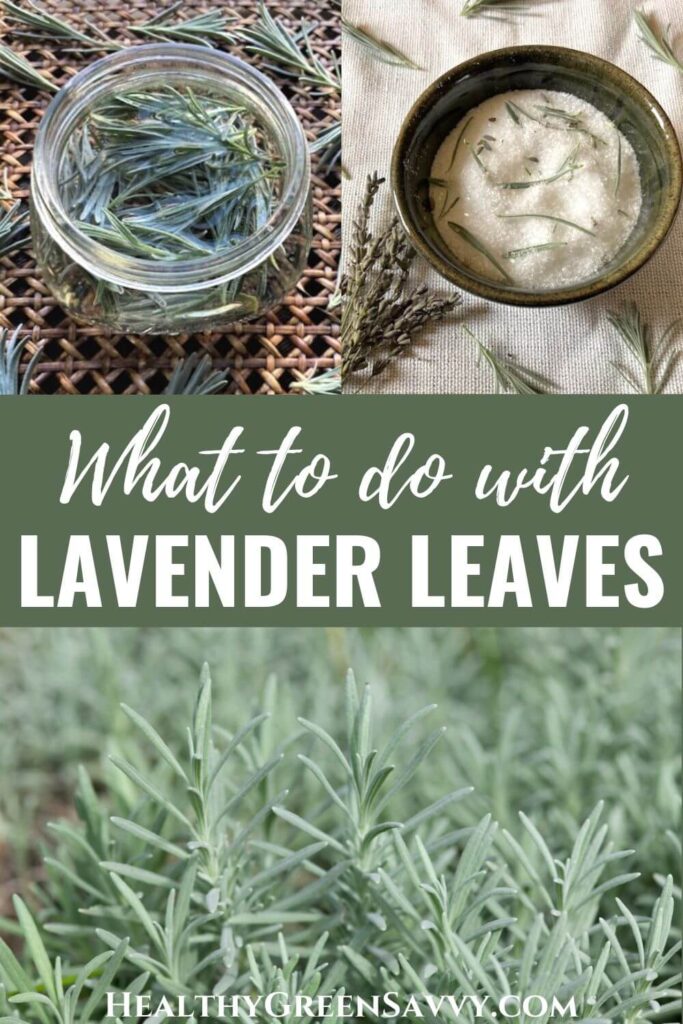
Additional photo credits in cover photo and pins: marinowifi, S847

Susannah is a proud garden geek and energy nerd who loves healthy food and natural remedies. Her work has appeared in Mother Earth Living, Ensia, Northern Gardener, Sierra, and on numerous websites. Her first book, Everything Elderberry, released in September 2020 and has been a #1 new release in holistic medicine, naturopathy, herb gardening, and other categories. Find out more and grab your copy here.
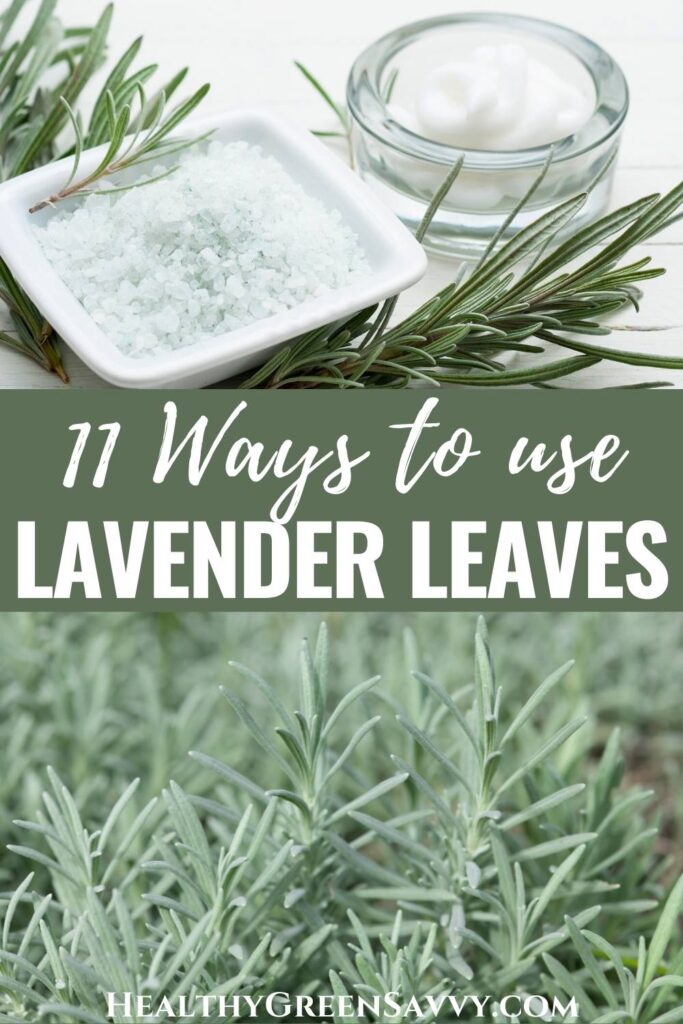
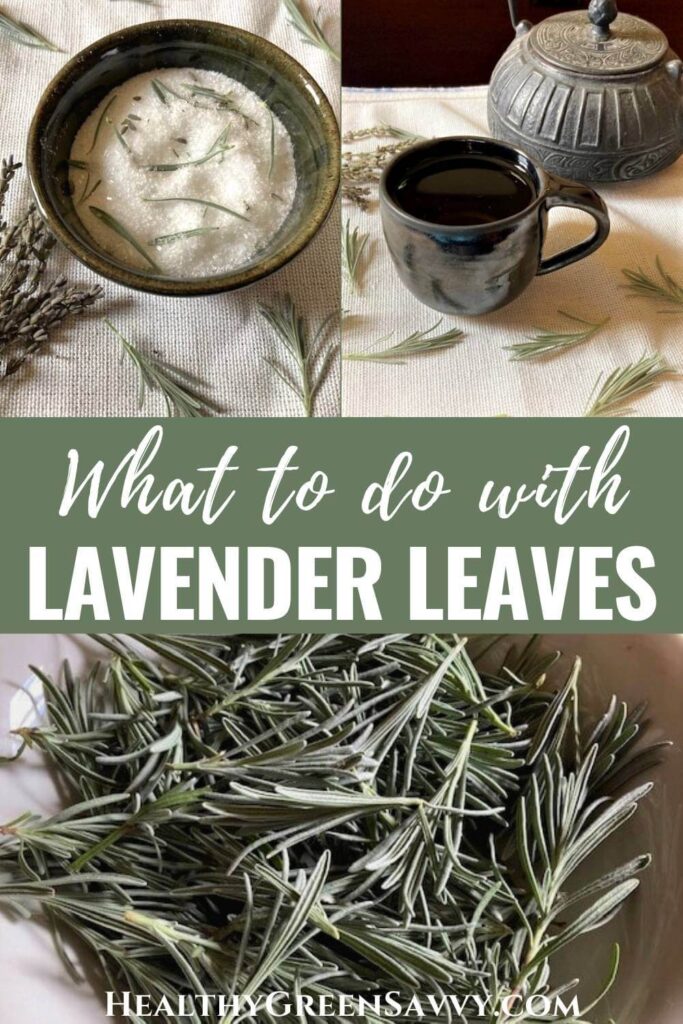
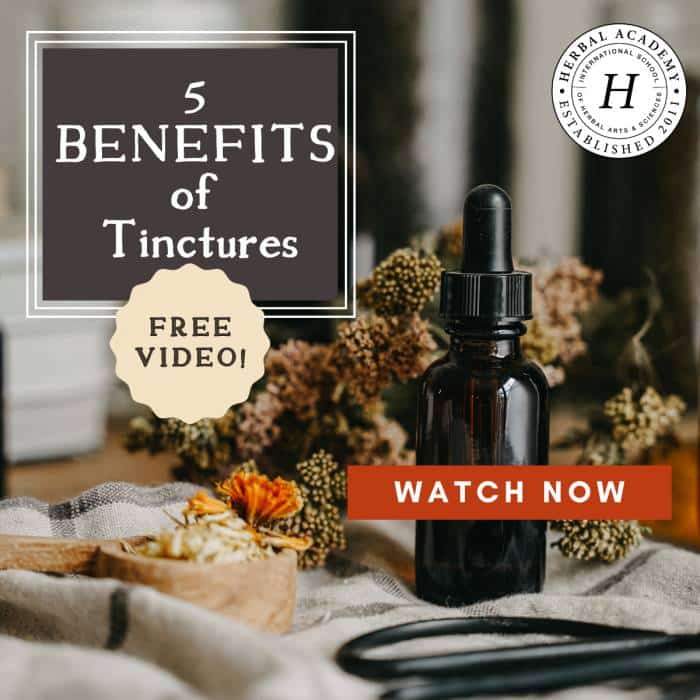
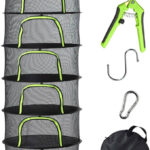
 Hi, I'm Susannah, a garden geek, energy nerd, and fan of healthy food and natural remedies. Need some simple, practical solutions for living healthier and greener? You've come to the right place! More about me and my green projects
Hi, I'm Susannah, a garden geek, energy nerd, and fan of healthy food and natural remedies. Need some simple, practical solutions for living healthier and greener? You've come to the right place! More about me and my green projects